
An Article from the May 2002 JOM: A Hypertext-Enhanced Article
 |
TMS
ONLINE | TMS
PUBLICATIONS | SITE
MAP An Article from the May 2002 JOM: A Hypertext-Enhanced Article |
|
|
|
|
The
author of this article is managing editor of JOM.
|
Exploring traditional, innovative, and revolutionary issues in the minerals,
metals, and materials fields.
|
| OUR LATEST ISSUE |
|
||
|
|
||
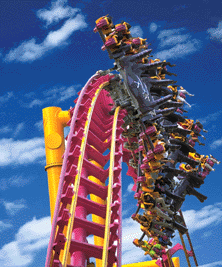 |
||
|
Figure 1. The X, which debuted in January at Six Flags Magic Mountain near Los Angeles, California, adds a new twist to an old ride with seats that rotate 360 degrees. Photo by Six Flags Magic Mountain. |
||
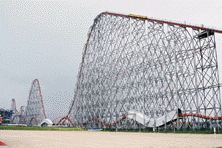 |
||
|
Figure 2. Steel Dragon, opened in Nagashima Spaland in Kuwana County, Japan in 2000. Photo by Joel Rogers at www.CoasterGallery.com. |
||
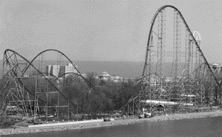 |
||
|
Figure 3. The Millennium Force, which opened in 2000 at Cedar Point in Sandusky, Ohio, has a descent angle of 80 degrees, a height of 94 meters and top speed of 148 km/h. When the ride opened, it was the tallest and fastest in the world. Photo by Cedar Point. |
||
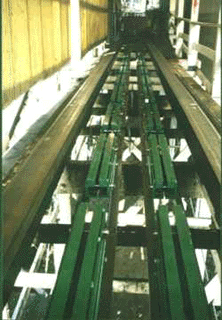 |
||
|
|
||
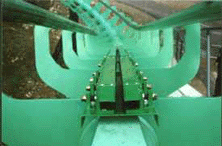 |
||
|
Figure 4. (a-top) Magnetic brakes installed in spring 2002 on the Jack Rabbit at Kennywood Park near Pittsburgh, Pennsylvania, replaced 80 year old manual brakes. Brakes are the rails in the center of the photo. (b-bottom) Magnetic brakes also were installed in Kennywood’s newest coaster, the Phantom’s Revenge, to ensure safe stopping of the high-speed ride. Photos by Magnetar Technologies Corporation. |
||
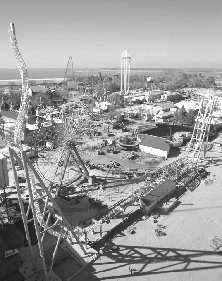 |
||
|
Figure 5. The Wicked Twister, under construction at Cedar Point in Sandusky, Ohio, will use a linear induction motor to launch riders up a 90 degree twisting tower. Photo by Cedar Point. |
What are amusement parks hoping for in 2002? Mostly, to fulfill the demands
of their thrill-seeking visitors for anything that’s bigger, better, and
faster than in 2001.
Thanks to new technology and materials, the parks and their visitors will get
their wish:
|
After a few enterprising businessmen found ways to mimic that ride in amusement
parks in the mid-1800s, a technological race began that has not ended yet. In
the early 1900s, parks competed to own the biggest, fastest, most innovative
roller coaster. Today, the race continues, and Alan Schilke is a participant.
An engineer for Arrow
Dynamics, he designed the X, a roller coaster that opened to much acclaim
in January at Six
Flags Magic Mountain (Figure 1).
The ride, which is the 15th roller coaster at Six
Flags Magic Mountain, places passengers in cars that are mounted alongside
the track, able to swivel and spin 360 degrees along the track’s climbs
and drops. Just as the market demands, the X is bigger, faster, and something
completely new. But, when taken in context of the thrill-ride history, this
competition for the next new roller coaster experience is unremarkable to Schilke.
“Actually, I don’t look at what’s going on now as something that’s
special,” Schilke said. “I would look at what happened between the
‘30s and the ‘70s as more of just a lull, because, with roller coasters
back at the turn of the century and in the ‘20s, they had a race then.
Basically, it fell apart with the Depression and the wars. If that wouldn’t
have happened I think we’d be way beyond where we are now. I see what’s
happening now as more natural, and even still, slow.”
As of February, the tallest coaster in the world was Superman The Escape, at
Six
Flags Magic Mountain, with a height of 126 meters. The fastest was Dodona,
at Fujikyu Highland,
with a top speed of 172 km/h. Although this business and its rankings change
rapidly, one fact remains the same: the demands placed on amusement ride materials
are escalating. Perhaps it’s no coincidence, then, that more tools than
ever are available to ensure rides are safely built and maintained.
Trevor Hite, general manager of the California office of Chance
Morgan, said computer programs are able to tell whether rides will be safe
before they are ever constructed. “We’ve made modifications in all
our programs to be able to better analyze not only the effects on the structure
and the human body, but the excitement of the rides, the aesthetics and thrill,”
he said.
Of course, that was not always the case. In the early days of roller coasters,
imagination outpaced technology. For instance, roller coasters were built in
the early 1900s with looped tracks to send riders racing upside down. But few
riders were willing to take advantage of the tracks, which were reported to
offer such a rough ride that the thrill was not worth the pain.
Now, computer programs can predict the riders’ experience, Hite said. For
instance, when D.H. Morgan
Manufacturing (which was bought in 2001 by Mike Chance) built the Steel
Dragon 2000 in Nagashima
Spaland in Kuwana County, Japan, it was the longest, fastest, and tallest
roller coaster in that country (Figure 2).
Before the ride opened to the public, computerized accelerometer testing and
biodynamic testing provided details on the effects on riders, Hite said. In
addition, technology ensured the coaster was built to provide a smooth ride.
“With computer-aided design, we can do more calculations. You can get an
infinite number of calculations,” Hite said. “In the past, you used
to do a calculation every 5 or 10 feet. Now you can do every inch, every foot,
whatever it takes.”
“We ride the ride before it’s biodynamically tested,” he said.
“We know that it’s safe.”
Roller coaster development advanced greatly some 10 years ago, he said, when
finite-element analysis programs and velocity programs became integrated to
provide a more complete picture of how a ride will operate. The programs provide
velocities and also forces on the members that support the coaster.
“The addition of more complete finite-element analysis and modeling has
made it easier to dial in your material sizing and joint connections . . .you
can dial things in tighter,” Hite said. That kind of precision allows rides
to be built with structural integrity that was not possible in the past.
For all the changes in roller coaster size and intensity, there have been surprisingly
few major advances in the materials and technology involved in their construction.
One most significant development came in 1912 when roller coaster designer and
builder John Miller was issued a patent for under friction wheels. Those wheels,
the third set on a roller coaster, locked the cars to the underside of the track
even as it rounded sharp bends or plummeted down steep hills, opening the door
to new generation of more thrilling roller coasters that could fill customers’
needs for bigger, better, and faster rides. Another of Miller’s inventions
was the safety chain dog, which prevents the roller coaster cars from rolling
backward if the lift chain breaks. Such innovations allowed roller coasters
in the 1920s to reach speeds of 96 km/h and heights of 30 meters.
For decades, the coaster competition played out on wooden tracks with steel
rails. The roller coaster experience changed dramatically, though, in 1959,
when Arrow Dynamics
built the Matterhorn for Disneyland
in Anaheim, California. That ride was the first to run on a tubular, all-steel
track. The cylindrical track allowed a new kind of twisting, turning, yet smooth
ride that was previously impossible. At first steel wheels ran on the steel
tracks, but wheels are now coated with a urethane compound that wear longer,
reduce friction, and make even higher speeds possible, Hite said.
“The cost (of wheels) has gone way up, but the complexity and durability
of the product has gone way up, too,” he said. Durability is especially
important because when wheels need to be replaced, a ride cannot run. And if
a ride is not running, a park is not profiting.
Wheels, which may be among the least exciting components of a new roller coaster,
are among the most responsible for its speed, Hite said.
At the Uremet Corporation, founder Mark Moore has found a niche in the roller coaster arms race, not only selling new wheels, but also refurbishing old wheels in the off-season, stripping off old urethane and applying a new coating. Uremet, which also provides materials for aerospace uses (an industry with similar performance requirements), has helped push roller coasters to higher speeds. “There have been some great changes in the urethane compound itself to allow for higher speeds on the coasters,” Moore said. The new product, Hylene PPDI, was developed by DuPont. The product, which has been used on roller coaster wheels for about five years, lowered the hysteretic value of the material and increased abrasion resistance, Moore said. For roller coaster enthusiasts, those characteristics translate to a smoother, faster ride.
The evolution of roller coaster materials and technology can be witnessed at
Cedar Point, in Sandusky,
Ohio. The sprawling park, which was voted the Best Theme Park in a 2001 survey
by the trade magazine Amusement
Today, will open this month with 15 roller coasters. Its offerings include
wooden coasters, such as the Blue Streak, dating back to 1964, and steel giants
such as the Millennium Force, which opened in 2000 at 94 meters high with a
maximum speed of 150 km/h. The Millennium Force, built for $25 million, was
the 2001 Amusement
Today winner in the Best Steel Coaster category (Figure
3).
Behind the hype and records at the park is Monty Jasper, vice president of
maintenance. Jasper oversees a staff that works round the clock to make sure
all rides are in top condition. Among its responsibilities, the crew is in charge
of maintaining 13.4 km of steel and wood track. Using nondestructive testing
methods, they examine the rails regularly, looking for parts that need to be
replaced.
“I don’t think the steel rides 20–25 years ago got nearly as
much inspection as they do today,” he said.
Jasper, with a master’s degree in mechanical engineering, said he has watched
the amusement industry evolve dramatically since he began work in this business
as a ride operator in 1973. “From a materials standpoint, there are lighter,
less expensive, stronger steels today than there were years ago,” Jasper
said. Some of the newest magnetic braking systems on roller coasters are equipped
with aluminum alloy brake fins.
The braking systems themselves offer a safer, smoother ride experience. As recently
as the 1970s, all roller coasters were built with mechanical brakes that needed
to be manually adjusted and that could malfunction in bad weather. “If
it rained that day they wouldn’t run a ride,” Jasper said.
The newest magnetic braking systems offer numerous benefits over the old, mechanical
brakes: They have no moving parts, require no control system, have no contact
surfaces, and thus, no wear and tear resulting from friction, according to Magnetar
Technologies Corporation, which markets Soft Stop Brakes to roller coaster
manufacturers. The brakes operate with a copper alloy fin (chosen for its strength
over aluminum alloys) mounted on the roller coaster. The fin travels between
two parallel rows of high-strength magnets. As the train rolls through the magnets,
they bring it to a smooth, gradual stop. The magnetic brakes can be placed at
points along a roller coaster track to slow the train down as needed.
The result, said Ed Pribonic, president of the company, is a passive system
that can operate in any weather, even if ice or grease is on the track or fin.
Magnetar has just installed the brakes on two roller coasters in Kennywood
Park in Pittsburgh, Pennsylvania. One set went onto the Phantom’s Revenge,
a steel coaster that opened in 2001 to replace the 1991 Steel Phantom, and the
other onto the Jack Rabbit, a wooden coaster designed by John Miller, dating
back to 1922 (Figures 4a and 4b).
Until now, the Jack Rabbit operated with its original skid brakes, Pribonic
said. Skid brakes involve two long blocks of wood built into the floor of the
station. When the ride operator pulls a lever, the blocks are raised, sliding
over plates of steel along the bottom of the car and dragging it to a stop.
Pribonic, who grew up in the Pittsburgh area riding Kennywood’s
coasters every summer, said the new magnetic brakes will allow the Jack Rabbit
to coast, rather than lurch, to a stop. On the Phantom’s Revenge, the revamped
ride was running faster than the park owners expected, he said, so the magnetic
brakes were installed to ensure that the incoming train would not approach the
outgoing train.
Magnets are also being used on new thrill rides as a launch system. Using a
linear induction motor, Cedar
Point’s new Wicked Twister will propel riders through the coaster’s
station at a maximum speed of 116 km/h in 2.5 seconds (Figure
5). The launch system, which is growing more popular in thrill rides and
roller coasters, replaces the traditional lift chain that pulls roller coaster
cars up a hill and releases them, allowing gravity to provide the energy necessary
for the coaster to complete the track circuit. The Wicked Twister, which opens
this month, will send its passengers up a 66 meter tall twisting steel tower.
The ride is propelled as a copper alloy fin passes through coils on the track.
“When we get ready to fire, we press a button and an electronic current
energizes the coils, projects a magnetic field between them, and the copper
alloy fin is in between,” Jasper said. The fin is pushed forward to the
next set of coils, and so on, picking up momentum along the way. The system,
which also involves magnetic brakes, is energy intensive, Jasper said.
“Let me put it this way: We’re using such a massive jolt of electricity
to operate Wicked Twister that it would be enough to power 550 average sized
houses,” he said. Other launch systems are achieving similar results, such
as linear synchronous motors or compressed air systems, reportedly taking passengers
from 0 to 129 km/h in 1.5 seconds.
Without a doubt, materials-driven technologies such as magnetic brakes and high-powered
launch systems have taken the roller coaster competition to new heights. Pribonic,
who has worked in this business for more than 20 years, believes materials are
going to have to improve to keep up with the increasing demands of high-intensity
rides. “Materials, by and large, haven’t changed,” he said. Although
rides are towering higher and moving faster than ever, old, familiar, and somewhat
mild steel, grade A-36 or higher, remains the preferred material for roller
coaster structures. Better options would be high-strength steel alloys, titanium,
or even advanced fibers, to fill the need for high-strength materials for roller
coaster structures.
“They’ve been meeting those challenges with mass rather than material
changes. . . . if they want to go any higher and faster, it’s going to
have to force a change in engineering approaches,” Pribonic said.
|
|
||||||||||||||||||||||
|
Top 10 Fastest Roller Coasters in
the World*
|
|||
|
Coaster
|
Park
|
Opened
|
Speed
km/h |
| Dodonpa |
Fujikyu Highland
|
12/21/2001
|
172
|
| Superman the Escape |
Six Flags Magic Mountain
|
3/15/1997
|
161
|
| Tower of Terror |
DreamWorld
|
1997
|
|
| Steel Dragon 2000 |
Nagashima Spa Land
|
8/1/2000
|
153
|
| Millennium Force |
Cedar Point
|
5/13/2000
|
150
|
| Goliath |
Six Flags Magic Mountain
|
2/11/2000
|
137
|
| Titan |
Six Flags Over Texas
|
4/27/2001
|
|
| Phantom’s Revenge |
Kennywood Park
|
5/19/2001
|
132
|
| Fujiyama |
Fujikyu Highland
|
7/1996
|
130
|
| Desperado |
Buffalo Bill’s Resort & Casino
|
1994
|
129
|
| Hypersonic XLC |
Paramount’s Kings Dominion
|
3/24/2001
|
|
| Nitro |
Six Flags Great Adventure
|
4/7/2001
|
|
| Son of Beast |
Paramount’s Kings Island
|
5/26/2000
|
126
|
| Superman–Ride of Steel |
Six Flags New England
|
5/5/2000
|
124
|
|
|
|||
| * Source: Rollercoaster Database, www.rcdb.com | |||
|
|
|||
|
Top 10 Tallest Roller Coasters in
the World*
|
|||
|
Coaster
|
Park
|
Opened
|
Height
(m) |
| Superman The Escape |
Six Flags Magic Mountain
|
3/15/1977
|
126
|
| Tower of Terror |
Dreamworld
|
1997
|
115
|
| Steel Dragon 2000 |
Nagashima Spa Land
|
8/1/2000
|
97
|
| Millennium Force |
Cedar Point
|
5/13/2000
|
94
|
| Fujiyama |
Fujikyu Highland
|
7/1996
|
79
|
| Titan |
Six Flags Over Texas
|
4/27/2001
|
75
|
| Goliath |
Six Flags Magic Mountain
|
2/11/2000
|
72
|
| Nitro |
Six Flags Great Adventure
|
4/7/2001
|
70
|
| Speed |
Nascar Café
|
4/28/2000
|
68
|
| Mr. Freeze |
Six Flags St. Louis
|
1998
|
|
| Mr. Freeze |
Six Flags Over Texas
|
1998
|
66
|
| Son of Beast |
Paramount’s Kings Island
|
5/26/2000
|
|
|
|
|||
| * Source: Rollercoaster Database, www.rcdb.com | |||
|
|
|||
Direct questions about this or any other JOM page to jom@tms.org.
| If you would like to comment on the May 2002 issue of JOM, simply complete the JOM on-line critique form | |||||
|---|---|---|---|---|---|
| Search | TMS Document Center | Subscriptions | Other Hypertext Articles | JOM | TMS OnLine |